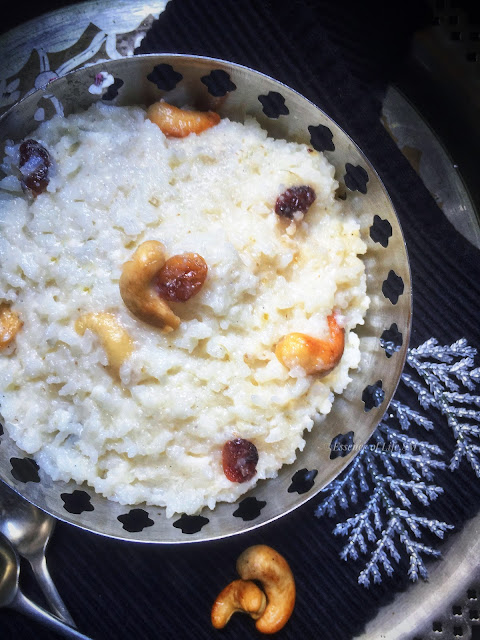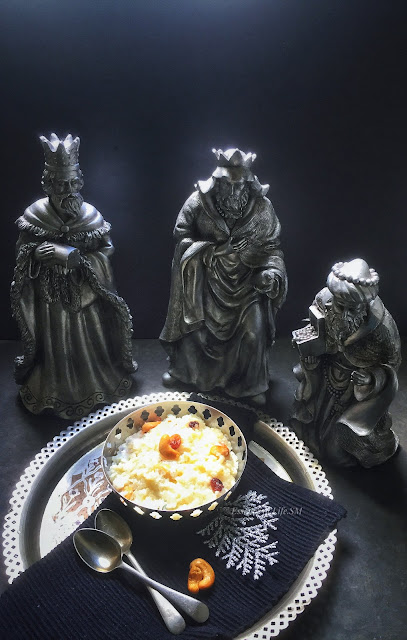Moonu Raja Pongal Recipe - Celebrate Epiphany with a A Royal South Indian Treat
Moonu Raja Pongal - Three Kings & A Karaikkal Classic South Indian Dessert |
Discovering the Tradition of Moonu Raja Pongal for Epiphany: A South Indian Surprise
I have to admit, I was a complete novice when it came to the tradition of making Pongal for Epiphany. A few years ago, I stumbled upon a television programme that shed light on the unique celebration of Epiphany by the people of Karaikkal and Pondicherry, the charming French town in India. To say I was intrigued would be an understatement! Imagine my surprise when I learned that there was a dish crafted specifically to mark the day—a recipe that was as traditional as it was uniquely South Indian. Who knew that humble ingredients like raw rice, coconut milk, and sugar could hold such significance?
The Regional Twist on Tradition
It’s fascinating how celebrations tend to adapt to the regions we live in, isn’t it? I’ve noticed how certain recipes undergo a transformation, acquiring a local flavour thanks to the ingredients at hand. Take, for example, the Pesaha Appam, traditionally made on Maundy Thursday. This dish, with its roots in the Passover bread, has evolved into a localized delight. Then there’s the case of Kozhukkattas, made on the eve of Palm Sunday—representing either Easter eggs or, the stones thrown at Jesus Christ. A dish to depict the suffering of the God - ironical though!!! It’s funny how a dish meant to depict divine suffering ends up being a tasty treat on our plates!
Epiphany, the Feast of The Three Kings
 |
Epiphany: The Feast of The Three Kings
The Adoration of the Magi
Every year on January 6th, we celebrate the Feast of the Three Kings, also known as Epiphany. This day, which marks the Twelfth Night after Christmas, holds a special place in the hearts of many. Some churches honour Epiphany to remember not only the visit of the Wise Men but also the Baptism of Jesus. According to tradition, these Three Wise Men—or Three Kings—visited the newborn Jesus, bringing with them gifts of Gold, Frankincense, and Myrrh, a resin cherished for its use in incense and perfumes. Epiphany, at its core, is the celebration of a great revelation—a manifestation that has inspired countless traditions worldwide.
Celebrating Epiphany: A Culinary Journey Across Cultures
Epiphany is celebrated in diverse ways across the globe—from grand processions of the Magi and gift-giving to more unique customs like present-delivering witches and brave souls plunging into icy waters. One of the most cherished traditions is the preparation of cakes with a hidden secret. The famous Three Kings Cake, often baked with a coin or almond inside, takes on various forms depending on the region. In some places, it’s a delicate French puff pastry filled with almond paste; in others, it’s a sponge cake brimming with almond cream. And then there are those who prefer a light fruitcake, which brings us to our twist—adding the Three Kings Pongal to this festive list.
 |
The Story Behind Moonu Raja Pongal: A Unique Tradition from Karaikkal and Pondicherry
Introducing the most traditional recipe from the Karaikkal and Pondicherry region of Tamil Nadu—a place steeped in history as a former French colony, where the influence still lingers. Meet the Moonu Raja Pongal, also known as the Three Kings Pongal, a dish that beautifully intertwines cultural heritage with culinary tradition. Coincidentally, this period also marks the Harvest Festival, Pongal, celebrated across Tamil Nadu.
But why is Pongal prepared on Epiphany in these regions? One fascinating explanation ties it to the three great kings who once ruled Tamil Nadu and parts of Kerala—the Chera, Chola, and Pandya dynasties, collectively known as the "Moovendars" or Three Kings. And voilà, we have a delightful revelation (or should I say, an Epiphany?) behind the name of this dish. With rice being a staple in the region and coconut a ubiquitous ingredient, it’s no wonder this combination became the foundation of Moonu Raja Pongal. Thus, this sweet dish, rooted in history, became a cherished tradition among the Christian communities of Pondicherry, Karaikkal, and their coastal surroundings.
Check out a wide collection of Authentic South Indian Desserts and Pongal Recipes to keep the festive spirit alive!
Cuisine - South Indian
Recipe Type - Sweet, Dessert
Difficulty - Medium
Serves - 3–4
Author - SM
Preparation Time - 15–20 Minutes
Cooking Time - 30–45 Minutes
"Epiphany Special: How to Make Moonu Raja Pongal, a Classic dish from Karaikkal"
 |
Ingredients for Moonu Raja Pongal
To Cook Rice:
- 1/2 cup Raw Rice (or Seeraga Samba rice)
- 2 cups Thin Coconut Milk
- A pinch of Salt (optional)
For Moonu Raja Pongal:
- 1 cup Thick Coconut Milk
- 1/2 cup Sugar
- 4-5 Cardamom Pods
For Garnishing:
- 2 tablespoons Ghee
- 8-10 Cashew Nuts
- 1 tablespoon Raisins
 |
Method - Step-by-step guide on How to Make Moonu Raja Pongal
Cooking the Rice
- Rinse the Rice: Clean and wash the rice 2–3 times, or until the water runs clear. If you're using Seeraga Samba rice, soak it for 20–30 minutes beforehand.
- Prepare the Rice: Drain the soaked rice and add it to a heavy-bottomed pan, or place it in a bowl with a lid inside a pressure cooker.
- Cook the Rice: Pour in 2 cups of thin coconut milk and a pinch of salt. Give it a quick stir. Cover the pressure cooker and cook on high flame for 2 whistles. Then, lower the flame and cook for another 2–3 whistles. Once done, switch off the flame and allow the pressure to release naturally.
Making the Moonu Raja Pongal
- Prepare the Cardamom: Grind the cardamom pods into a fine powder using a mixer-grinder. Set aside.
- Combine Ingredients: Slightly mash the cooked rice. Add sugar and the cardamom powder, mixing well. Keep this on a very low flame until the sugar is fully absorbed into the rice.
- Add Coconut Milk: Pour in 1 cup of thick coconut milk and continue cooking on a low flame until the pongal reaches your desired consistency.
- Garnish: In a separate pan, heat 2 tablespoons of ghee. Roast the cashew nuts until they turn golden brown and the raisins fluff up. Pour this fragrant mixture over the Moonu Raja Pongal and mix well.
- Serve: Serve the Moonu Raja Pongal hot with an extra drizzle of ghee on top for added richness.
 |
| Moonu Raja Pongal - A Closer Look at Tradition |
Cooking Tips & Notes:
- Rice Selection: I’ve used Seeraga Samba, a fragrant variety of rice that adds a lovely aroma to the Pongal. You can also substitute it with Chinigura or Basmati rice.
- Traditional Recipe: Traditionally, raw rice is used in this recipe.
- Coconut Milk: Adjust the amount of coconut milk based on the rice variety you choose. For this recipe, I used the second and third extracts of coconut milk to cook the rice.
- Sweetness: Feel free to adjust the sweetness to your taste preference. Can substitute sugar with rock sugar or jaggery.
A Sweet Epiphany: Moonu Raja Pongal Deserves a Spot on Your Table
Moonu Raja Pongal is more than just a dish—it's a delicious blend of history, tradition, and flavour that will transport you straight to the heart of Tamil Nadu's rich cultural tapestry. Whether you're celebrating Epiphany, Pongal, or simply craving something sweet and comforting, this traditional South Indian dessert promises to delight your taste buds with its creamy texture, fragrant rice, and the warmth of coconut milk.
As you savour each spoonful, you’re not just enjoying a dessert; you’re partaking in a centuries-old tradition that has been lovingly passed down through generations. So, why not bring a taste of Tamil Nadu into your home? Try this recipe today, and let the flavours of Moonu Raja Pongal create an unforgettable culinary experience and keep the festive spirit alive in your kitchen!
Don’t miss out on other Traditional Tamil Nadu Recipes that bring the flavours to your table. Click here for more culinary delights! Love what you see? Subscribe to Essence of Life - Food, for more delicious recipes, cooking tips, and foodie inspiration delivered straight to your inbox.









0 comments